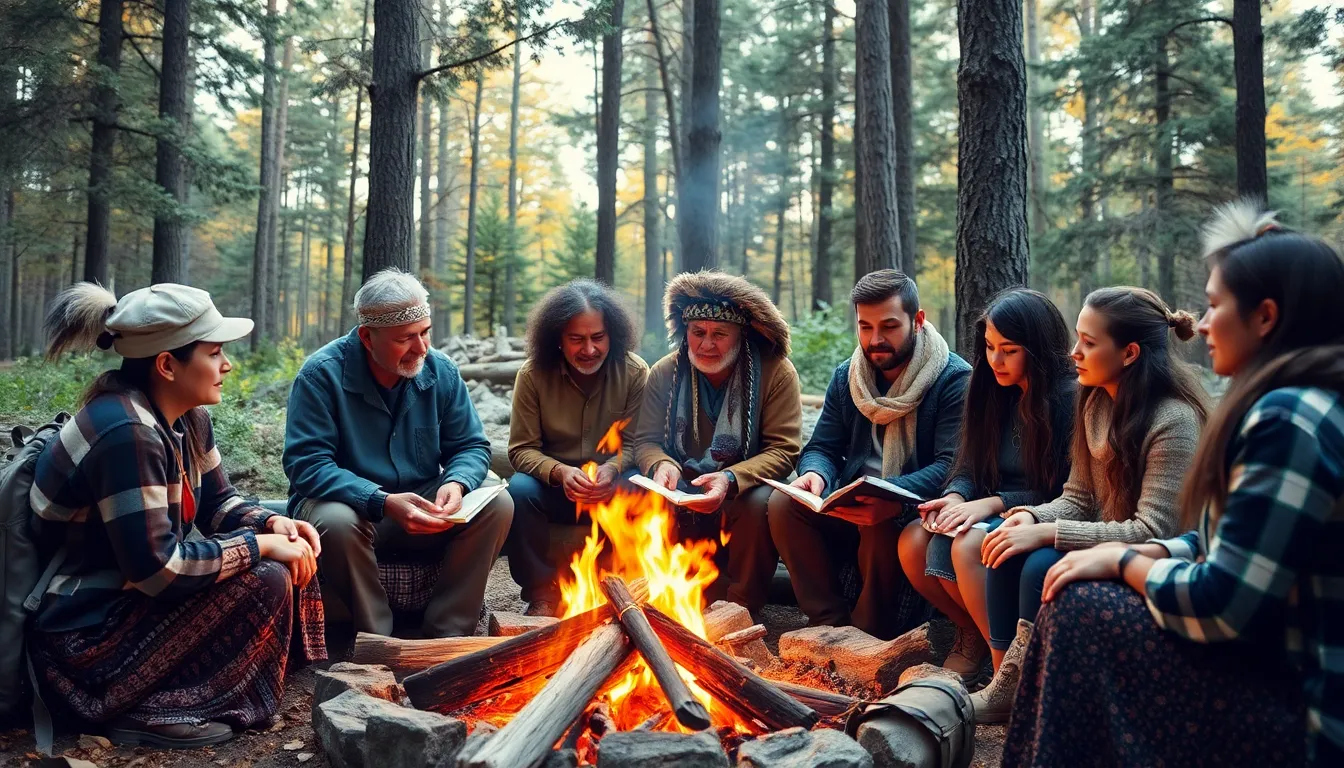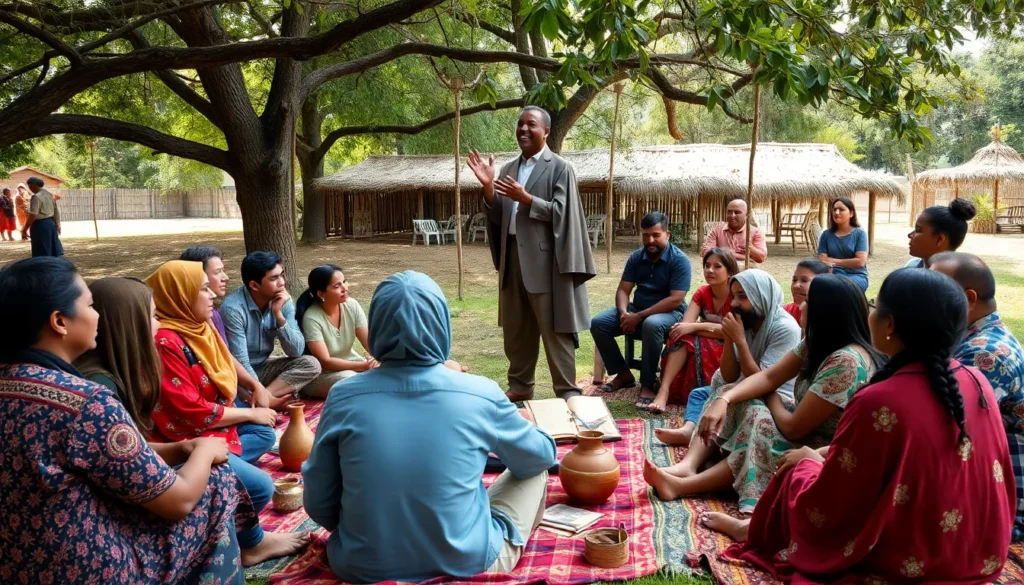In a world overflowing with content, cultural storytelling stands out like a unicorn in a sea of horses. It’s not just about sharing tales; it’s about weaving the rich tapestry of traditions, beliefs, and experiences that shape communities. When done right, it can transport listeners to distant lands and times, making them feel like they’ve just sipped a cup of chai in a bustling market or danced under the stars at a festival.
Imagine the power of a good story—one that resonates across generations and bridges gaps between cultures. Cultural storytelling isn’t just a nostalgic trip down memory lane; it’s a vital tool for connection and understanding in our increasingly diverse world. So, buckle up as we dive into the art of storytelling that not only entertains but also enlightens, bringing people together one tale at a time.
Table of Contents
ToggleOverview of Cultural Storytelling
Cultural storytelling serves as a vital tool for sharing and preserving community heritage. Traditions, values, and beliefs are often transmitted through narratives that encapsulate a culture’s essence. Various forms of storytelling, including oral histories, written literature, and performance art, create connections among individuals across generations.
Each culture possesses unique stories reflecting its experiences and historical contexts. Such stories foster a sense of belonging and identity among group members. They often highlight shared challenges, triumphs, and moral lessons, promoting empathy and understanding.
Storytelling also plays a significant role in education and knowledge transfer. Teachers and mentors use stories to illustrate complex concepts or to impart wisdom. Engaging characters and relatable scenarios capture attention, enabling easier comprehension.
Additionally, cultural storytelling adapts to modern platforms, reaching diverse audiences via social media, podcasts, and documentaries. Through these mediums, traditional stories gain new life, sparking interest in cultural heritage among younger generations. By embracing technology, storytelling evolves while retaining its core values.
Importantly, the impact of a story transcends entertainment alone. Well-crafted narratives encourage critical thinking and open discussions about cultural differences. Finding common ground through storytelling promotes collaboration and respect among varied cultures.
Cultural storytelling enriches society, amplifying voices that might otherwise remain unheard. As platforms for expression continue to grow, the power of storytelling remains pivotal in fostering a harmonious global community.
Importance of Cultural Storytelling

Cultural storytelling plays a crucial role in maintaining the fabric of communities by sharing their unique narratives. This practice fosters a deeper understanding of shared values.
Preserving Traditions
Traditions find preservation through storytelling. Oral histories pass down rituals and customs, ensuring cultural practices endure. Written literature solidifies these stories, allowing them to be revisited over generations. Performance art breathes life into age-old tales, connecting audiences to their roots. Engaging with these narratives reinforces cultural identity and helps maintain a sense of belonging. Communities benefit through the collective remembrance of ancestral wisdom and experiences.
Fostering Community
Communities thrive through shared stories. Tales unite individuals, forming connections based on common experiences and beliefs. This sense of belonging strengthens social bonds and encourages participation in communal activities. Storytelling events create spaces where diverse voices contribute, enriching the cultural tapestry. As people share their narratives, they cultivate empathy and understanding among different backgrounds. This collaborative atmosphere soars beyond mere entertainment, creating a supportive environment for societal growth and dialogue.
Techniques in Cultural Storytelling
Cultural storytelling employs various techniques that resonate deeply with communities, ensuring the transmission of values and traditions. Two prominent methods include oral traditions and visual storytelling.
Oral Traditions
Oral traditions encompass narratives passed down through generations by word of mouth. These stories often reflect cultural heritage, moral lessons, and community history. Storytellers frequently use engaging language and expressive performances to captivate their audience. Each tale strengthens community bonds and fosters a shared identity. Additionally, oral traditions preserve unique dialects and expressions, adding nuance to the narrative. Generational storytelling creates a connection between the past and present, enriching cultural awareness.
Visual Storytelling
Visual storytelling employs imagery to convey cultural narratives effectively. This technique includes illustrations, paintings, photographs, and films that depict significant cultural themes. Visual elements enhance storytelling by providing context and emotional depth. Artists and filmmakers capture diverse experiences, allowing viewers to engage with narratives on multiple levels. Cultural symbols embedded in visuals often evoke familiarity and shared understanding among audiences. Through visual storytelling, broader audiences can appreciate specific traditions and viewpoints, promoting cross-cultural dialogue and appreciation.
Impact of Cultural Storytelling in Modern Society
Cultural storytelling holds immense significance in today’s society. It fosters community connections by sharing traditions and beliefs. Through narratives, cultural identity gets preserved and transmitted across generations. Oral histories, written literature, and performance art illustrate this diversity, uniting individuals with shared experiences.
Transformative power emerges from a well-told story that can resonate with listeners. Narratives enhance education by simplifying complex concepts, which engages learners more effectively. Furthermore, storytelling adapts to modern platforms. Social media and podcasts broaden reach and spark interest in cultural heritage, especially among younger audiences.
Such adaptability encourages critical thinking. Discussions about cultural differences arise, promoting collaboration and respect. Communities see strengthening social bonds through shared narratives, fostering empathy and understanding.
Cultural traditions undergo preservation through storytelling, where oral histories pass down customs and rituals. Written literature solidifies these tales for the future, creating a repository of cultural identity. Engaging performance art revitalizes age-old stories, making them relatable.
In addition, visual storytelling employs imagery, such as illustrations and films, to enhance emotional depth. Diverse audiences engage with these rich cultural narratives, promoting cross-cultural dialogue. The impact transcends entertainment, enriching society by amplifying previously unheard voices.
Cultural storytelling is a powerful force that shapes communities and fosters understanding. By sharing unique narratives, it preserves traditions and strengthens cultural identities. The adaptability of storytelling to modern platforms ensures that these vital narratives reach new audiences, especially younger generations.
As individuals engage with stories from diverse cultures, they cultivate empathy and appreciation for different experiences. This process not only enriches personal perspectives but also contributes to a more harmonious global society. Ultimately, cultural storytelling remains essential in weaving the fabric of community, promoting dialogue, and amplifying voices that deserve to be heard.





